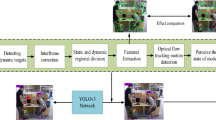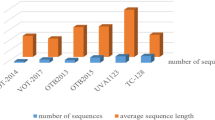Abstract
This paper proposed a non- monitoring video multi- object tracking algorithm based on fast resampling particle wave filtering in order to improve the unsupervised monitoring effect of video moving objects. Each particle (sample) can represent the real state assumption. In each time step, the likelihood function is used to evaluate and quantify each particle. The estimated state is approximated by the average value of all the particles after evaluating each particle. To avoid degradation, we use particle resampling to create a new weighing set. Finally, by the simulation test of a real monitoring image show that the proposed algorithm improves the tracking accuracy by more than 20% and the computational efficiency by more than 30% compared with the contrast algorithm, which verifies the effectiveness of the proposed method.




Similar content being viewed by others
References
Achary UR, YukiHagiwara SN, Deshpande SS, Koh JEW, Shu Lih O, Arunkumar N, Ciaccio EJ, Lim CM (2019) Characterization of focal EEG signals: a review. Futur Gener Comput Syst 91:290–299
Benjamini Y, Yekutieli D (2001) The control of the false discovery rate in multiple testing under dependency[J]. Ann Stat 29(4):1165–1188
Benko M, Härdle W, Kneip A (2009) Common functional principal components[J]. Ann Stat 37(1):1–34
Dongdong J, Arunkumar N, Wenyu Z, Beibei L, Xinlei Z, Guangjian Z (2019) Semantic clustering fuzzy c means spectral model based comparative analysis of cardiac color ultrasound and electrocardiogram in patients with left ventricular heart failure and cardiomyopathy. Futur Gener Comput Syst 92:324–328
Elamaran V, Arunkumar N, Hussein AF, Solarte M, Ramirez-Gonzalez G (2018) Spectral fault recovery analysis revisited with normal and abnormal heart sound signals. IEEE Access 6:62874–62879
Haoyu L, Jianxing L, Arunkumar N, Hussein AF, Jaber MM (2018) An IoMT cloud-based real time sleep apnea detection scheme by using the SpO2 estimation supported by heart rate variability. Futur Gener Comput Syst. https://doi.org/10.1016/j.future.2018.12.001
Jiajie L, Narasimhan K, Elamaran V, Arunkumar N, Solarte M, Ramirez-Gonzalez G (2018) Clinical decision support system for alcoholism detection using the analysis of EEG signals. IEEE Access 6:61457–61461
Khamparia A, Singh A, Anand D et al (2018) A novel deep learning-based multi-model ensemble method for the prediction of neuromuscular disorders. Neural Comput & Applic. https://doi.org/10.1007/s00521-018-3896-0
Khan JA, Van Aelst S, Zamar RH (2010) Fast robust estimation of prediction error based on resampling[J]. Computational Statistics & Data Analysis 54(12):3121–3130
Li R (2013) An object tracking algorithm based on global SURF feature[J]. Journal of Information & Computational Science 10(7):2159–2167
Medeiros H, Holguín G, Shin PJ et al (2010) A parallel histogram-based particle filter for object tracking on SIMD-based smart cameras[J]. Comput Vis Image Underst 114(11):1264–1272
Mihaylova L, Angelova D, Honary S et al (2007) Mobility tracking in cellular networks using particle filtering[J]. IEEE Trans Wirel Commun 6(10):3589–3599
Nei M (1996) Phylogenetic analysis in molecular evolutionary genetics[J]. Annu Rev Genet 30(1):371–403
Oh SL, Hagiwara Y, Raghavendra U, Yuvaraj R, Arunkumar N, Murugappan M, Acharya UR (2018) A deep learning approach for Parkinson’s disease diagnosis from EEG signals. Neural Comput & Applic:1–7. https://doi.org/10.1007/s00521-018-3689-5
Santamaria-Granados L, Munoz-Organero M, Ramirez-Gonzalez G, Abdulhay E, Arunkumar N (2018) Using deep convolutional neural network for emotion detection on a physiological signals dataset (AMIGOS). IEEE Access. https://doi.org/10.1109/ACCESS.2018.2883213
Sathishkumar BR, Sundaravadivazhagan B, Martin B, Sasi G, Chandrasekar M, Kumar SR, … Arunkumar N Revisiting computer networking protocols by wireless sniffing on brain signal/image portals. Neural Comput & Applic:1–13. https://doi.org/10.1007/s00521-018-3919-x
Tsingos N, Gallo E, Drettakis G (2004) Perceptual audio rendering of complex virtual environments[J]. ACM Trans Graph (TOG) 23(3):249–258
Turechek WW, Madden L (1999) Spatial pattern analysis of strawberry leaf blight in perennial production systems.[J]. Phytopathology 89(5):421–433
Wu Z, Wang H, Arunkumar N (2019) Bayesian analysis model for the use of anesthetic analgesic drugs in cancer patients based on geometry reconstruction. Futur Gener Comput Syst 93:170–175
Yuan M, Kendziorski C, Li H et al (2006) Hidden Markov models for microarray time course data in multiple biological conditions [with discussions, rejoinder][J]. Publ Am Stat Assoc 101(476):1323–1332
Zhao H, Duan X, Cao Y (2007) Color-based object tracking using fast survival-of-the-fittest method[C]. In: International conference on fuzzy systems and knowledge discovery. IEEE, pp 311–316
Acknowledgements
Anhui province outstanding young talents support program (gxyq2017157, gxyq2017159); Anhui province major teaching reform project(2016jyxm0777); Anhui natural science research project (KJ2017A838, KJ2017A837, KJ2018A0669, KJ2018A0670).
Author information
Authors and Affiliations
Corresponding author
Additional information
Publisher’s note
Springer Nature remains neutral with regard to jurisdictional claims in published maps and institutional affiliations.
Rights and permissions
About this article
Cite this article
Feng, Y., Liu, H. & Zhao, S. Moving target recognition and tracking algorithm based on multi-source information perception. Multimed Tools Appl 79, 16941–16954 (2020). https://doi.org/10.1007/s11042-019-7483-x
Received:
Revised:
Accepted:
Published:
Issue Date:
DOI: https://doi.org/10.1007/s11042-019-7483-x




